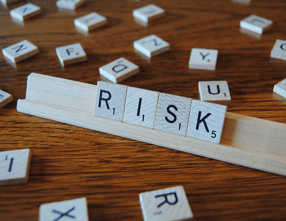
If you have a financial advisor who manages your investments, at some point you most likely completed a multiple choice risk tolerance questionnaire and answered some version of the following hypothetical question:
If the stock market dropped 20% in one week, would you:
a) Sell 100% of your stock positions
b) Sell a portion of your stock positions
c) Use the downturn as an opportunity to buy at a lower price point
d) Not make any changes to your portfolio
So as you sit in the comfort of your home or office and contemplate the answers to the above types of what-if questions, thinking and feeling like you’re able to tolerate higher levels of risk is very common and easy to do.
After all, it’s one thing to imagine having the risk tolerance to see your portfolio drop 20% in one week and not panic. But in real life, when it really does happen, that’s when an investor discovers their true tolerance for risk.
If you slept well the night of the hypothetical 20% drop in the stock market, chances are you have a very high tolerance for risk and would most likely be considered an aggressive investor. Aggressive investors want to take risk, lots of it, and usually like to have portfolios constructed that have at least 80% of their investments on the equity side of the ledger if not 100%.
Risk CapacityThe other component of assessing risk is your capacity for risk taking. Never should an investor or potential investor confuse risk tolerance with risk capacity. To do so could and often will lead to awful consequences.
Say your risk tolerance answers assessed you as aggressive. At our firm, an aggressive risk tolerance score would mean a portfolio constructed with a 95% allocation to stocks and a 5% allocation to bonds. Stock market volatility is this type of investor’s best friend. This is a high risk, high reward investment strategy.
With a 95% allocation to the stock market, the potential hit to your portfolio if/when the markets have a wicked downturn would be significant.
Now imagine you retired in your early 50’s. You’ve been a risk taker your whole life, in fact that’s how you were able to achieve much of your financial success. You live large because that’s the way you roll. Your portfolio is your only source of income. So far, your high risk taking has been a winning strategy and you see no reason to change course.
Over the past few years, your annual spending has increased rapidly but you’re not concerned about it because your high risk investing strategy has paid-off in a big way. The bull market we’ve had has made you feel invincible. You invested in a start-up, purchased a second home, bought a new Tesla and racked up lots of new debt because the banks were making it so easy to borrow.
Then, a crisis somewhere on the globe occurs and the stock market drops 20% - not in a week, but in two days. You shrug it off, only to watch the market drop another 20% the following day. Suddenly, it dawns on you that although you have a high tolerance for risk, the capacity you have to take risk was not as high as you had imagined or hoped.
As you slowly start to assess the damage, you realize that the lifestyle that you’ve grown accustomed to is about to get altered in a big way. In order to meet your monthly overhead costs, you need to withdraw the same amount of money from your portfolio as you’ve been doing - only now, you’re doing it with a portfolio that’s lower in value by 40%.
To add insult to injury, after blowing through the 5% of bonds in your portfolio, and because you did not set aside any emergency reserve cash funds in the event of a stock market crash like this, you’re now forced into selling your stock positions at a huge loss. What were unrealized losses in your portfolio suddenly become realized losses.
In the course of one week, your life as you knew it, your lifestyle has changed dramatically. Loans and lines of credit you established over the past few years that seemed like no big deal now feel like an albatross around your neck. How did your life turn so quickly from living the dream to living the nightmare?
Eyes Wide Open
Although the above is a fictional story, there are plenty of people taking much more risk than they have the capacity to handle. Taking risk, even being an aggressive investor - it’s all good, but please, do not purely use a risk tolerance questionnaire to make that crucial decision. It’s just too important to rely strictly on that one data point.
A financial advisor looking out for YOUR best interests and not their own, will always go deeper and play the role of devil’s advocate by modeling worse case scenarios before recommending an investment strategy. Only then can you understand your true capacity for risk.
Many investors are do it yourselfers and going it alone has its advantages for sure, yet from what I’ve observed, most of these investors tend to focus too much on best case scenarios and too little on worse case.
So the moral of this story is - never confuse risk tolerance with risk capacity and never underestimate the value of a professional, independent and objective, second opinion. That opinion could and often is worth its weight in gold.

